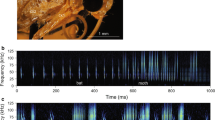Summary
-
1.
YoungHipposideros speoris emit multiharmonic sounds in groups of three to four notes. Newborns emit a relatively uniform pattern of FM- and FM/CF/FM-sounds. From ten days of age onwards the initial sound (first note) of a group is a FM-sound whereas the successive ones are CF/FM-sounds of consistently higher frequencies. At prevolant and volant stages of the bat's development most of the sound energy is concentrated in the second harmonic which is raised to the frequency range of the adults' CF/FM-sounds (127–138 kHz). Subsequently other harmonics disappear.
-
2.
Harmonic components are suppressed or filtered out when they fall in a frequency range of approximately 65–75 kHz. This was found for bats of different ages regardless which fundamental frequency the suppressed harmonic components corresponded to, indicating a mechanical filtering process. These measurements coincide with the absence of the first harmonics in the same frequency range in the sounds of adults.
-
3.
Temporal sound emission patterns were measured for bats of different ages. There was an increase in sound duration and an increase in the number of sounds (notes) per group as the bat matured to adulthood.
-
4.
The sound emission of juveniles aids mothers in finding their young ones. Mothers located their infants even when the juveniles were displaced far from where they were left behind by their mothers. Behavioral experiments under both natural and captive conditions showed that the sound emission of young ones attracts mothers but do not give sufficient cues to allow the mother to discriminate their own from a group of young.
-
5.
The ontogeny of the two types of sounds (CF/FM and complex harmonic FM) of adultHipposideros speoris is discussed and compared with the vocalisations of other bat species.
Similar content being viewed by others
Abbreviations
- CF :
-
constant frequency
- FM :
-
frequency modulated
References
Brown PE, Grinnell AD (1980) Echolocation ontogeny in bats. In: Busnel R-G, Fish JF (eds) Animal sonar systems. Plenum Press, New York, pp 355–377
Gould E (1971) Studies of maternal-infant communication and development of vocalizations in the batsMyotis andEptesicus. Commun Behav Biol 5:263–313
Gould E (1975a) Neonatal vocalizations in bats of eight genera. J Mammal 56:15–29
Gould E (1975b) Experimental studies of the ontogeny of ultrasonic vocalizations in bats. Dev Psychobiol 8:333–346
Gould E (1979) Neonatal vocalizations often species of Malaysian bats (Megachiroptera and Microchiroptera). Am Zool 19:481–491
Grinnell AD, Hagiwara S (1972) Adaptations of the auditory nervous system for echolocation. Z Vergl Physiol 76:41–81
Habersetzer J (1981) Adaptive echolocation sounds in the batRhinopoma hardwickei. A field study. J Comp Physiol 144:559–566
Habersetzer J (1985) Flügelmorphologische Untersuchungen an einer Fledermausgesellschaft in Madurai. In: Nachtigall W (ed) BIONA reports 5: Bat flight — Fledermausflug. Publ Akad Wiss Lit Mainz, Gustav Fischer, Stuttgart, pp 86–106
Habersetzer J, Schuller G, Neuweiler G (1984) Foraging behaviour and Doppler shift compensation in echolocating hipposiderid bats,Hipposideros bicolor andHipposideros speoris. J Comp Physiol A 155:559–567
Jones C (1967) Growth, development, and wing loading in the evening bat,Nycticeius humeralis (Rafinesque). J Mammal 48:1–19
Kay L, Pickvance TJ (1963) Ultrasonic emissions of the lesser horseshoe batRhinolophus hipposideros (Bech). Proc Zool Soc Lond 141:163–172
Konstantinov AI (1973) Development of echolocation in bats in postnatal ontogenesis. Period Biol 75:13–19
Kulzer E (1962) Über die Jugendentwicklung der Angola-BulldogfledermausTadarida (Mops) condylura (A Smith 1833) (Mollossidae). Säugetierkundl Mitt 10:116–124
Matsumura S (1979) Mother-infant communication in a horseshoe bat (Rhinolophus ferrumequinum nippon): development of vocalization. J Mammal 60:76–84
Neuweiler G (1983) Echolocation and adaptivity to ecological constraints. In: Huber F, Markl H (eds) Neuroethology and behavioral physiology. Akad Wiss Mainz, pp 280–302
Neuweiler G, Bruns V, Schuller G (1980) Ears adapted for the detection of motion, or how echolocating bats have exploited the capacities of the mammalian auditory system. J Acoust Soc Am 68:741–753
Neuweiler G, Singh S, Sripathi K (1984) Audiograms of a South Indian bat community. J Comp Physiol A 154:133–142
Novick A (1958) Orientation in Paleotropical bats. I. Microchiroptera. J Exp Zool 138:81–154
Schmidt U (1972) Die sozialen Laute juveniler Vampirfledermäuse (Desmodus rotundus) und ihrer Mütter. Zool Beitr 23:310–316
Schuller G (1980) Hearing characteristics and Doppler shift compensation in South Indian CF-FM bats. J Comp Physiol 139:349–356
Turner D, Shaughnessy A, Gould E (1972) Individual recognition between mother and infant bats (Myotis). In: Galler SR et al. (eds) Animal orientation and navigation. National Aeronautics and Space Administration, NASA SP-262, Washington, DC, pp 365–371
Author information
Authors and Affiliations
Rights and permissions
About this article
Cite this article
Habersetzer, J., Marimuthu, G. Ontogeny of sounds in the echolocating batHipposideros speoris . J. Comp. Physiol. 158, 247–257 (1986). https://doi.org/10.1007/BF01338568
Accepted:
Issue Date:
DOI: https://doi.org/10.1007/BF01338568




